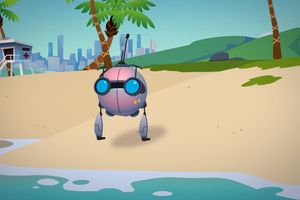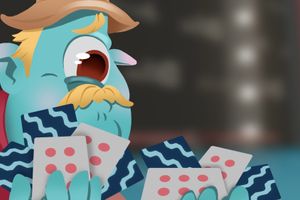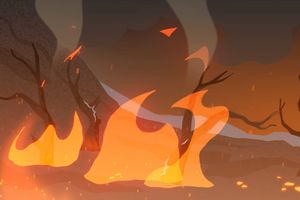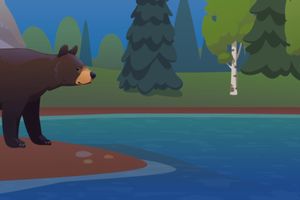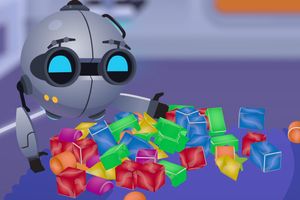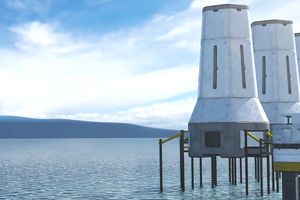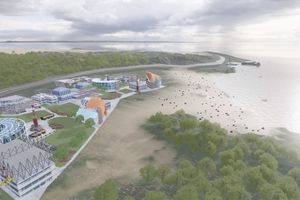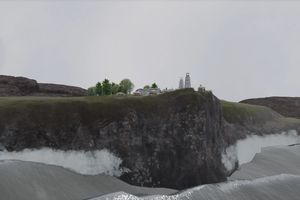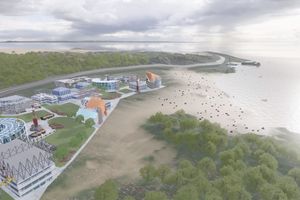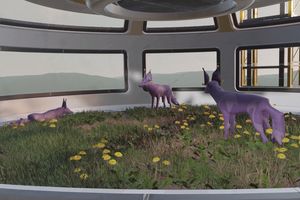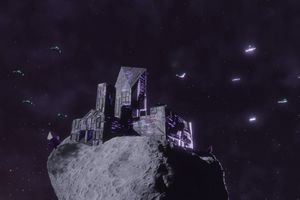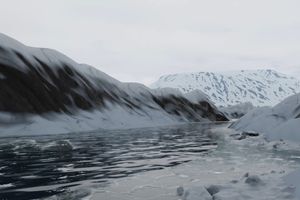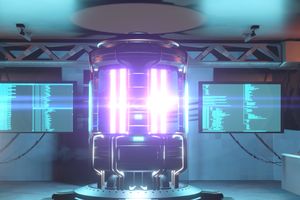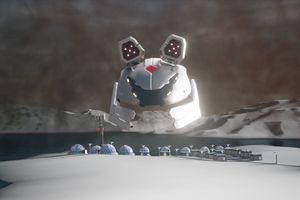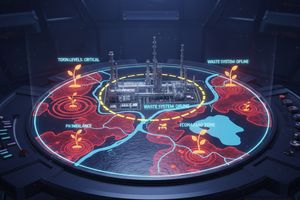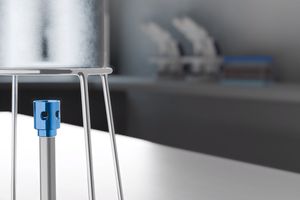Standards Alignment
| Standard Code | Grade | NGSS Evidence Outcomes | Missions |
|---|---|---|---|
| K-ESS2-1 | K | 1 Mission | |
NGSS Evidence OutcomesUse and share observations of local weather conditions to describe patterns over time. | |||
| K-ESS2-2 | K | 1 Mission | |
NGSS Evidence OutcomesConstruct an argument supported by evidence for how plants and animals (including humans) can change the environment to meet their needs. | |||
| K-ESS3-1 | K | 1 Mission | |
NGSS Evidence OutcomesUse a model to represent the relationship between the needs of different plants or animals (including humans) and the places they live. | |||
| K-ESS3-2 | K | 1 Mission | |
NGSS Evidence OutcomesAsk questions to obtain information about the purpose of weather forecasting to prepare for, and respond to, severe weather. | |||
| K-ESS3-3 | K | No Missions | |
NGSS Evidence OutcomesCommunicate solutions that will reduce the impact of humans on the land, water, air, and/or other living things in the local environment. | |||
| K-LS1-1 | K | 1 Mission | |
NGSS Evidence OutcomesUse observations to describe patterns of what plants and animals (including humans) need to survive. | |||
| K-PS2-1 | K | 1 Mission | |
NGSS Evidence OutcomesPlan and conduct an investigation to compare the effects of different strengths or different directions of pushes and pulls on the motion of an object. | |||
| K-PS2-2 | K | 1 Mission | |
NGSS Evidence OutcomesAnalyze data to determine if a design solution works as intended to change the speed or direction of an object with a push or a pull. | |||
| K-PS3-1 | K | 1 Mission | |
NGSS Evidence OutcomesMake observations to determine the effect of sunlight on Earth's surface. | |||
| K-PS3-2 | K | 1 Mission | |
NGSS Evidence OutcomesUse tools and materials to design and build a structure that will reduce the warming effect of sunlight on an area. | |||
| 1-ESS1-1 | 1 | 1 Mission | |
NGSS Evidence OutcomesUse observations of the sun, moon, and stars to describe patterns that can be predicted. | |||
| 1-ESS1-2 | 1 | 1 Mission | |
NGSS Evidence OutcomesMake observations at different times of year to relate the amount of daylight to the time of year. | |||
| 1-LS1-1 | 1 | No Missions | |
NGSS Evidence OutcomesUse materials to design a solution to a human problem by mimicking how plants and/or animals use their external parts to help them survive, grow, and meet their needs. | |||
| 1-LS1-2 | 1 | 1 Mission | |
NGSS Evidence OutcomesRead texts and use media to determine patterns in behavior of parents and offspring that help offspring survive. Examples of patterns of behaviors could include the signals that offspring make (such as crying, cheeping, and other vocalizations) and the responses of the parents (such as feeding, comforting, and protecting the offspring) . | |||
| 1-LS3-1 | 1 | 1 Mission | |
NGSS Evidence OutcomesMake observations to construct an evidence-based account that young plants and animals are like, but not exactly like, their parents. | |||
| 1-PS4-1 | 1 | 1 Mission | |
NGSS Evidence OutcomesPlan and conduct investigations to provide evidence that vibrating materials can make sound and that sound can make materials vibrate. | |||
| 1-PS4-2 | 1 | 1 Mission | |
NGSS Evidence OutcomesMake observations to construct an evidence-based account that objects in darkness can be seen only when illuminated. | |||
| 1-PS4-3 | 1 | 1 Mission | |
NGSS Evidence OutcomesPlan and conduct an investigation to determine the effect of placing objects made with different materials in the path of a beam of light. | |||
| 1-PS4-4 | 1 | 1 Mission | |
NGSS Evidence OutcomesUse tools and materials to design and build a device that uses light or sound to solve the problem of communicating over a distance. | |||
| 2-ESS1-1 | 2 | 1 Mission | |
NGSS Evidence OutcomesUse information from several sources to provide evidence that Earth events can occur quickly or slowly. | |||
| 2-ESS2-1 | 2 | 1 Mission | |
NGSS Evidence OutcomesCompare multiple solutions designed to slow or prevent wind or water from changing the shape of the land. | |||
| 2-ESS2-2 | 2 | 1 Mission | |
NGSS Evidence OutcomesDevelop a model to represent the shapes and kinds of land and bodies of water in an area. | |||
| 2-ESS2-3 | 2 | 1 Mission | |
NGSS Evidence OutcomesObtain information to identify where water is found on Earth and that it can be solid or liquid. | |||
| 2-LS2-1 | 2 | 1 Mission | |
NGSS Evidence OutcomesPlan and conduct an investigation to determine if plants need sunlight and water to grow. | |||
| 2-LS2-2 | 2 | 1 Mission | |
NGSS Evidence OutcomesDevelop a simple model that mimics the function of an animal in dispersing seeds or pollinating plants. | |||
| 2-LS4-1 | 2 | 1 Mission | |
NGSS Evidence OutcomesMake observations of plants and animals to compare the diversity of life in different habitats. | |||
| 2-PS1-1 | 2 | 1 Mission | |
NGSS Evidence OutcomesPlan and conduct an investigation to describe and classify different kinds of materials by their observable properties. | |||
| 2-PS1-2 | 2 | 1 Mission | |
NGSS Evidence OutcomesAnalyze data obtained from testing different materials to determine which materials have the properties that are best suited for an intended purpose. | |||
| 2-PS1-3 | 2 | 1 Mission | |
NGSS Evidence OutcomesMake observations to construct an evidence-based account of how an object made of a small set of pieces can be disassembled and made into a new object. | |||
| 2-PS1-4 | 2 | 1 Mission | |
NGSS Evidence OutcomesConstruct an argument with evidence that some changes caused by heating or cooling can be reversed and some cannot. | |||
| K-2-ETS1-1 | K-2 | 2 Missions | |
NGSS Evidence OutcomesAsk questions, make observations, and gather information about a situation people want to change to define a simple problem that can be solved through the development of a new or improved object or tool. | |||
| K-2-ETS1-2 | K-2 | 1 Mission | |
NGSS Evidence OutcomesDevelop a simple sketch, drawing, or physical model to illustrate how the shape of an object helps it function as needed to solve a given problem. | |||
| K-2-ETS1-3 | K-2 | 1 Mission | |
NGSS Evidence OutcomesAnalyze data from tests of two objects designed to solve the same problem to compare the strengths and weaknesses of how each performs. | |||
| 3-ESS2-1 | 3 | 1 Mission | |
NGSS Evidence OutcomesRepresent data in tables and graphical displays to describe typical weather conditions expected during a particular season. | |||
| 3-ESS2-2 | 3 | 1 Mission | |
NGSS Evidence OutcomesObtain and combine information to describe climates in different regions of the world. | |||
| 3-ESS3-1 | 3 | 1 Mission | |
NGSS Evidence OutcomesMake a claim about the merit of a design solution that reduces the impacts of a weather-related hazard. | |||
| 3-LS1-1 | 3 | 1 Mission | |
NGSS Evidence OutcomesDevelop models to describe that organisms have unique and diverse life cycles but all have in common birth, growth, reproduction, and death. | |||
| 3-LS2-1 | 3 | No Missions | |
NGSS Evidence OutcomesConstruct an argument that some animals form groups that help members survive. | |||
| 3-LS3-1 | 3 | 1 Mission | |
NGSS Evidence OutcomesAnalyze and interpret data to provide evidence that plants and animals have traits inherited from parents and that variation of these traits exists in a group of similar organisms. | |||
| 3-LS3-2 | 3 | 2 Missions | |
NGSS Evidence OutcomesUse evidence to support the explanation that traits can be influenced by the environment. | |||
| 3-LS4-1 | 3 | 1 Mission | |
NGSS Evidence OutcomesAnalyze and interpret data from fossils to provide evidence of the organisms and the environments in which they lived long ago. | |||
| 3-LS4-2 | 3 | No Missions | |
NGSS Evidence OutcomesUse evidence to construct an explanation for how the variations in characteristics among individuals of the same species may provide advantages in surviving, finding mates, and reproducing. | |||
| 3-LS4-3 | 3 | 1 Mission | |
NGSS Evidence OutcomesConstruct an argument with evidence that in a particular habitat some organisms can survive well, some survive less well, and some cannot survive at all. | |||
| 3-LS4-4 | 3 | 1 Mission | |
NGSS Evidence OutcomesMake a claim about the merit of a solution to a problem caused when the environment changes and the types of plants and animals that live there may change. | |||
| 3-PS2-1 | 3 | 1 Mission | |
NGSS Evidence OutcomesPlan and conduct an investigation to provide evidence of the effects of balanced and unbalanced forces on the motion of an object. | |||
| 3-PS2-2 | 3 | 1 Mission | |
NGSS Evidence OutcomesMake observations and/or measurements of an object's motion to provide evidence that a pattern can be used to predict future motion. | |||
| 3-PS2-3 | 3 | 1 Mission | |
NGSS Evidence OutcomesAsk questions to determine cause and effect relationships of electric or magnetic interactions between two objects not in contact with each other. | |||
| 3-PS2-4 | 3 | 1 Mission | |
NGSS Evidence OutcomesDefine a simple design problem that can be solved by applying scientific ideas about magnets. | |||
| 4-ESS1-1 | 4 | 1 Mission | |
NGSS Evidence OutcomesIdentify evidence from patterns in rock formations and fossils in rock layers to support an explanation for changes in a landscape over time. | |||
| 4-ESS2-1 | 4 | 1 Mission | |
NGSS Evidence OutcomesMake observations and/or measurements to provide evidence of the effects of weathering or the rate of erosion by water, ice, wind, or vegetation. | |||
| 4-ESS2-2 | 4 | No Missions | |
NGSS Evidence OutcomesAnalyze and interpret data from maps to describe patterns of Earth's features. | |||
| 4-ESS3-1 | 4 | No Missions | |
NGSS Evidence OutcomesObtain and combine information to describe that energy and fuels are derived from natural resources and that their uses affect the environment. | |||
| 4-ESS3-2 | 4 | 1 Mission | |
NGSS Evidence OutcomesGenerate and compare multiple solutions to reduce the impacts of natural Earth processes on humans. | |||
| 4-LS1-1 | 4 | 1 Mission | |
NGSS Evidence OutcomesConstruct an argument that plants and animals have internal and external structures that function to support survival, growth, behavior, and reproduction. | |||
| 4-LS1-2 | 4 | No Missions | |
NGSS Evidence OutcomesUse a model to describe that animals receive different types of information through their senses, process the information in their brain, and respond to the information in different ways. | |||
| 4-PS3-1 | 4 | 1 Mission | |
NGSS Evidence OutcomesUse evidence to construct an explanation relating the speed of an object to the energy of that object. | |||
| 4-PS3-2 | 4 | No Missions | |
NGSS Evidence OutcomesMake observations to provide evidence that energy can be transferred from place to place by sound, light, heat, and electric currents. | |||
| 4-PS3-3 | 4 | No Missions | |
NGSS Evidence OutcomesAsk questions and predict outcomes about the changes in energy that occur when objects collide. | |||
| 4-PS3-4 | 4 | No Missions | |
NGSS Evidence OutcomesApply scientific ideas to design, test, and refine a device that converts energy from one form to another. | |||
| 4-PS4-1 | 4 | 1 Mission | |
NGSS Evidence OutcomesDevelop a model of waves to describe patterns in terms of amplitude and wavelength and that waves can cause objects to move. | |||
| 4-PS4-2 | 4 | No Missions | |
NGSS Evidence OutcomesDevelop a model to describe that light reflecting from objects and entering the eye allows objects to be seen. | |||
| 4-PS4-3 | 4 | 1 Mission | |
NGSS Evidence OutcomesGenerate and compare multiple solutions that use patterns to transfer information. | |||
| 5-ESS1-1 | 5 | 1 Mission | |
NGSS Evidence OutcomesSupport an argument that differences in the apparent brightness of the sun compared to other stars is due to their relative distances from Earth. | |||
| 5-ESS1-2 | 5 | 1 Mission | |
NGSS Evidence OutcomesRepresent data in graphical displays to reveal patterns of daily changes in length and direction of shadows, day and night, and the seasonal appearance of some stars in the night sky. Examples of patterns could include the position and motion of Earth with respect to the sun and selected stars that are visible only in particular months. Assessment does not include causes of seasons. | |||
| 5-ESS2-1 | 5 | 1 Mission | |
NGSS Evidence OutcomesDevelop a model using an example to describe ways the geosphere, biosphere, hydrosphere, and/or atmosphere interact. | |||
| 5-ESS2-2 | 5 | 1 Mission | |
NGSS Evidence OutcomesDescribe and graph the amounts of salt water and fresh water in various reservoirs to provide evidence about the distribution of water on Earth. | |||
| 5-ESS3-1 | 5 | 1 Mission | |
NGSS Evidence OutcomesObtain and combine information about ways individual communities use science ideas to protect the Earth's resources and environment. | |||
| 5-LS1-1 | 5 | No Missions | |
NGSS Evidence OutcomesSupport an argument that plants get the materials they need for growth chiefly from air and water. | |||
| 5-LS2-1 | 5 | 1 Mission | |
NGSS Evidence OutcomesDevelop a model to describe the movement of matter among plants, animals, decomposers, and the environment. | |||
| 5-PS1-1 | 5 | 1 Mission | |
NGSS Evidence OutcomesDevelop a model to describe that matter is made of particles too small to be seen. | |||
| 5-PS1-2 | 5 | 1 Mission | |
NGSS Evidence OutcomesMeasure and graph quantities to provide evidence that regardless of the type of change that occurs when heating, cooling, or mixing substances, the total weight of matter is conserved. | |||
| 5-PS1-3 | 5 | 1 Mission | |
NGSS Evidence OutcomesMake observations and measurements to identify materials based on their properties. | |||
| 5-PS1-4 | 5 | 1 Mission | |
NGSS Evidence OutcomesConduct an investigation to determine whether the mixing of two or more substances results in new substances. | |||
| 5-PS2-1 | 5 | 1 Mission | |
NGSS Evidence OutcomesSupport an argument that the gravitational force exerted by Earth on objects is directed down. | |||
| 5-PS3-1 | 5 | No Missions | |
NGSS Evidence OutcomesUse models to describe that energy in animals' food (used for body repair, growth, motion, and to maintain body warmth) was once energy from the sun. | |||
| 3-5-ETS1-1 | 3-5 | 3 Missions | |
NGSS Evidence OutcomesDefine a simple design problem reflecting a need or a want that includes specified criteria for success and constraints on materials, time, or cost. | |||
| 3-5-ETS1-2 | 3-5 | 3 Missions | |
NGSS Evidence OutcomesGenerate and compare multiple possible solutions to a problem based on how well each is likely to meet the criteria and constraints of the problem. | |||
| 3-5-ETS1-3 | 3-5 | 1 Mission | |
NGSS Evidence OutcomesPlan and carry out fair tests in which variables are controlled and failure points are considered to identify aspects of a model or prototype that can be improved. | |||
| MS-ESS1-1 | MS | No Missions | |
NGSS Evidence OutcomesDevelop and use a model of the Earth-sun-moon system to describe the cyclic patterns of lunar phases, eclipses of the sun and moon, and seasons. | |||
| MS-ESS1-2 | MS | 1 Mission | |
NGSS Evidence OutcomesDevelop and use a model to describe the role of gravity in the motions within galaxies and the solar system. | |||
| MS-ESS1-3 | MS | 1 Mission | |
NGSS Evidence OutcomesAnalyze and interpret data to determine scale properties of objects in the solar system. | |||
| MS-ESS1-4 | MS | No Missions | |
NGSS Evidence OutcomesConstruct a scientific explanation based on evidence from rock strata for how the geologic time scale is used to organize Earth's 4.6-billion-year-old history. | |||
| MS-ESS2-1 | MS | No Missions | |
NGSS Evidence OutcomesDevelop a model to describe the cycling of Earth's materials and the flow of energy that drives this process. | |||
| MS-ESS2-2 | MS | 1 Mission | |
NGSS Evidence OutcomesConstruct an explanation based on evidence for how geoscience processes have changed Earth's surface at varying time and spatial scales. Emphasis is on how processes change Earth's surface at time and spatial scales that can be large (such as slow plate motions or the uplift of large mountain ranges) or small (such as rapid landslides or microscopic geochemical reactions), and how many geoscience processes (such as earthquakes, volcanoes, and meteor impacts) usually behave gradually but are punctuated by catastrophic events. | |||
| MS-ESS2-3 | MS | No Missions | |
NGSS Evidence OutcomesAnalyze and interpret data on the distribution of fossils and rocks, continental shapes, and seafloor structures to provide evidence of the past plate motions. | |||
| MS-ESS2-4 | MS | 1 Mission | |
NGSS Evidence OutcomesDevelop a model to describe the cycling of water through Earth's systems driven by energy from the sun and the force of gravity. | |||
| MS-ESS2-5 | MS | No Missions | |
NGSS Evidence OutcomesCollect data to provide evidence for how the motions and complex interactions of air masses result in changes in weather conditions. | |||
| MS-ESS2-6 | MS | No Missions | |
NGSS Evidence OutcomesDevelop and use a model to describe how unequal heating and rotation of the Earth cause patterns of atmospheric and oceanic circulation that determine regional climates. | |||
| MS-ESS3-1 | MS | No Missions | |
NGSS Evidence OutcomesConstruct a scientific explanation based on evidence for how the uneven distributions of Earth's mineral, energy, and groundwater resources are the result of past and current geoscience processes. | |||
| MS-ESS3-2 | MS | No Missions | |
NGSS Evidence OutcomesAnalyze and interpret data on natural hazards to forecast future catastrophic events and inform the development of technologies to mitigate their effects. | |||
| MS-ESS3-3 | MS | No Missions | |
NGSS Evidence OutcomesApply scientific principles to design a method for monitoring and minimizing a human impact on the environment. | |||
| MS-ESS3-4 | MS | No Missions | |
NGSS Evidence OutcomesConstruct an argument supported by evidence for how increases in human population and per-capita consumption of natural resources impact Earth's systems. | |||
| MS-ESS3-5 | MS | No Missions | |
NGSS Evidence OutcomesAsk questions to clarify evidence of the factors that have caused the rise in global temperatures over the past century. | |||
| MS-ETS1-1 | MS | 1 Mission | |
NGSS Evidence OutcomesDefine the criteria and constraints of a design problem with sufficient precision to ensure a successful solution, taking into account relevant scientific principles and potential impacts on people and the natural environment that may limit possible solutions. | |||
| MS-ETS1-2 | MS | 3 Missions | |
NGSS Evidence OutcomesEvaluate competing design solutions using a systematic process to determine how well they meet the criteria and constraints of the problem. | |||
| MS-ETS1-3 | MS | 2 Missions | |
NGSS Evidence OutcomesAnalyze data from tests to determine similarities and differences among several design solutions to identify the best characteristics of each that can be combined into a new solution to better meet the criteria for success. | |||
| MS-ETS1-4 | MS | No Missions | |
NGSS Evidence OutcomesDevelop a model to generate data for iterative testing and modification of a proposed object, tool, or process such that an optimal design can be achieved. | |||
| MS-LS1-1 | MS | No Missions | |
NGSS Evidence OutcomesConduct an investigation to provide evidence that living things are made of cells; either one cell or many different numbers and types of cells. | |||
| MS-LS1-2 | MS | No Missions | |
NGSS Evidence OutcomesDevelop and use a model to describe the function of a cell as a whole and ways the parts of cells contribute to the function. | |||
| MS-LS1-3 | MS | 1 Mission | |
NGSS Evidence OutcomesUse argument supported by evidence for how the body is a system of interacting subsystems composed of groups of cells. | |||
| MS-LS1-4 | MS | No Missions | |
NGSS Evidence OutcomesUse argument based on empirical evidence and scientific reasoning to support an explanation for how characteristic animal behaviors and specialized plant structures affect the probability of successful reproduction of animals and plants respectively. | |||
| MS-LS1-5 | MS | No Missions | |
NGSS Evidence OutcomesConstruct a scientific explanation based on evidence for how environmental and genetic factors influence the growth of organisms. | |||
| MS-LS1-6 | MS | 1 Mission | |
NGSS Evidence OutcomesConstruct a scientific explanation based on evidence for the role of photosynthesis in the cycling of matter and flow of energy into and out of organisms. | |||
| MS-LS1-7 | MS | No Missions | |
NGSS Evidence OutcomesDevelop a model to describe how food is rearranged through chemical reactions forming new molecules that support growth and/or release energy as this matter moves through an organism. | |||
| MS-LS1-8 | MS | No Missions | |
NGSS Evidence OutcomesGather and synthesize information that sensory receptors respond to stimuli by sending messages to the brain for immediate behavior or storage as memories. | |||
| MS-LS2-1 | MS | No Missions | |
NGSS Evidence OutcomesAnalyze and interpret data to provide evidence for the effects of resource availability on organisms and populations of organisms in an ecosystem. | |||
| MS-LS2-2 | MS | 1 Mission | |
NGSS Evidence OutcomesConstruct an explanation that predicts patterns of interactions among organisms across multiple ecosystems. | |||
| MS-LS2-3 | MS | No Missions | |
NGSS Evidence OutcomesDevelop a model to describe the cycling of matter and flow of energy among living and nonliving parts of an ecosystem. | |||
| MS-LS2-4 | MS | 1 Mission | |
NGSS Evidence OutcomesConstruct an argument supported by empirical evidence that changes to physical or biological components of an ecosystem affect populations. | |||
| MS-LS2-5 | MS | 1 Mission | |
NGSS Evidence OutcomesEvaluate competing design solutions for maintaining biodiversity and ecosystem services. | |||
| MS-LS3-1 | MS | No Missions | |
NGSS Evidence OutcomesDevelop and use a model to describe why structural changes to genes (mutations) located on chromosomes may affect proteins and may result in harmful, beneficial, or neutral effects to the structure and function of the organism. | |||
| MS-LS3-2 | MS | No Missions | |
NGSS Evidence OutcomesDevelop and use a model to describe why asexual reproduction results in offspring with identical genetic information and sexual reproduction results in offspring with genetic variation. | |||
| MS-LS4-1 | MS | No Missions | |
NGSS Evidence OutcomesAnalyze and interpret data for patterns in the fossil record that document the existence, diversity, extinction, and change of life forms throughout the history of life on Earth under the assumption that natural laws operate today as in the past. | |||
| MS-LS4-2 | MS | No Missions | |
NGSS Evidence OutcomesApply scientific ideas to construct an explanation for the anatomical similarities and differences among modern organisms and between modern and fossil organisms to infer evolutionary relationships. | |||
| MS-LS4-3 | MS | No Missions | |
NGSS Evidence OutcomesAnalyze displays of pictorial data to compare patterns of similarities in the embryological development across multiple species to identify relationships not evident in the fully formed anatomy. | |||
| MS-LS4-4 | MS | No Missions | |
NGSS Evidence OutcomesConstruct an explanation based on evidence that describes how genetic variations of traits in a population increase some individuals' probability of surviving and reproducing in a specific environment. | |||
| MS-LS4-5 | MS | No Missions | |
NGSS Evidence OutcomesGather and synthesize information about technologies that have changed the way humans influence the inheritance of desired traits in organisms. | |||
| MS-LS4-6 | MS | No Missions | |
NGSS Evidence OutcomesUse mathematical representations to support explanations of how natural selection may lead to increases and decreases of specific traits in populations over time. | |||
| MS-PS1-1 | MS | 1 Mission | |
NGSS Evidence OutcomesDevelop models to describe the atomic composition of simple molecules and extended structures. | |||
| MS-PS1-2 | MS | 1 Mission | |
NGSS Evidence OutcomesAnalyze and interpret data on the properties of substances before and after the substances interact to determine if a chemical reaction has occurred. | |||
| MS-PS1-3 | MS | No Missions | |
NGSS Evidence OutcomesGather and make sense of information to describe that synthetic materials come from natural resources and impact society. | |||
| MS-PS1-4 | MS | 1 Mission | |
NGSS Evidence OutcomesDevelop a model that predicts and describes changes in particle motion, temperature, and state of a pure substance when thermal energy is added or removed. | |||
| MS-PS1-5 | MS | No Missions | |
NGSS Evidence OutcomesDevelop and use a model to describe how the total number of atoms does not change in a chemical reaction and thus mass is conserved. | |||
| MS-PS1-6 | MS | No Missions | |
NGSS Evidence OutcomesUndertake a design project to construct, test, and modify a device that either releases or absorbs thermal energy by chemical processes. | |||
| MS-PS2-1 | MS | No Missions | |
NGSS Evidence OutcomesApply Newton's Third Law to design a solution to a problem involving the motion of two colliding objects. | |||
| MS-PS2-2 | MS | 1 Mission | |
NGSS Evidence OutcomesPlan an investigation to provide evidence that the change in an object's motion depends on the sum of the forces on the object and the mass of the object. | |||
| MS-PS2-3 | MS | No Missions | |
NGSS Evidence OutcomesAsk questions about data to determine the factors that affect the strength of electric and magnetic forces. | |||
| MS-PS2-4 | MS | No Missions | |
NGSS Evidence OutcomesConstruct and present arguments using evidence to support the claim that gravitational interactions are attractive and depend on the masses of interacting objects. | |||
| MS-PS2-5 | MS | No Missions | |
NGSS Evidence OutcomesConduct an investigation and evaluate the experimental design to provide evidence that fields exist between objects exerting forces on each other even though the objects are not in contact. | |||
| MS-PS3-1 | MS | No Missions | |
NGSS Evidence OutcomesConstruct and interpret graphical displays of data to describe the relationships of kinetic energy to the mass of an object and to the speed of an object. | |||
| MS-PS3-2 | MS | No Missions | |
NGSS Evidence OutcomesDevelop a model to describe that when the arrangement of objects interacting at a distance changes, different amounts of potential energy are stored in the system. | |||
| MS-PS3-3 | MS | No Missions | |
NGSS Evidence OutcomesApply scientific principles to design, construct, and test a device that either minimizes or maximizes thermal energy transfer. | |||
| MS-PS3-4 | MS | No Missions | |
NGSS Evidence OutcomesPlan an investigation to determine the relationships among the energy transferred, the type of matter, the mass, and the change in the average kinetic energy of the particles as measured by the temperature of the sample. | |||
| MS-PS3-5 | MS | No Missions | |
NGSS Evidence OutcomesConstruct, use, and present arguments to support the claim that when the kinetic energy of an object changes, energy is transferred to or from the object. | |||
| MS-PS4-1 | MS | 1 Mission | |
NGSS Evidence OutcomesUse mathematical representations to describe a simple model for waves that includes how the amplitude of a wave is related to the energy in a wave. | |||
| MS-PS4-2 | MS | 1 Mission | |
NGSS Evidence OutcomesDevelop and use a model to describe that waves are reflected, absorbed, or transmitted through various materials. | |||
| MS-PS4-3 | MS | No Missions | |
NGSS Evidence OutcomesIntegrate qualitative scientific and technical information to support the claim that digitized signals are a more reliable way to encode and transmit information than analog signals. | |||






